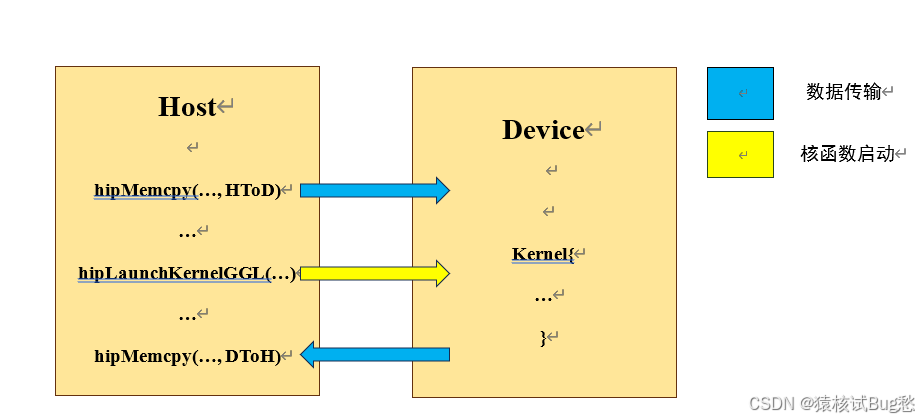目录
一、概述
HIP属于显式编程模型,需要在程序中明确写出并行控制语句,包括数据传输、核函数启动等。核函数是运行在DCU上的函数,在CPU端运行的部分称为主机端(主要是执行管理和启动),DCU端运行的部分称为设备端(用于执行计算)。大概的流程如下图:

①主机端将需要并行计算的数据通过hipMemcpy()传递给DCU(将CPU存储的内容传递给DCU的显存);
②调用核函数启动函数hipLaunchKernelGGL()启动DCU,开始执行计算;
③设备端将计算好的结果数据通过hipMemcpy()从DCU复制回CPU。
hipMemcpy()是阻塞式的,数据复制完成后才可以执行后续的程序;hipLanuchKernelGGL()是非阻塞式的,执行完后程序继续向后执行,但是在Kernel没有计算完成之前,最后一个hipMemcpy()是不会开始的,这是由于HIP的Stream机制。
二、程序实现
下面是对归约的具体实现,reduce.cpp:
#include <stdio.h>
#include <stdlib.h>
#include <hip/hip_runtime.h>
#include <hip/hip_runtime_api.h>
int recursiveReduce(int *data, int const size)
{
if (size == 1) return data[0];
int const stride = size / 2;
for (int i = 0; i < stride; i++)
{
data[i] += data[i + stride];
}
return recursiveReduce(data, stride);
}
__global__ void reduceNeighbored (int *g_idata, int *g_odata, unsigned int n)
{
unsigned int tid = threadIdx.x;
unsigned int idx = blockIdx.x * blockDim.x + threadIdx.x;
int *idata = g_idata + blockIdx.x * blockDim.x;
if (idx >= n) return;
for (int stride = 1; stride < blockDim.x; stride *= 2)
{
if ((tid % (2 * stride)) == 0)
{
idata[tid] += idata[tid + stride];
}
__syncthreads();
}
if (tid == 0) g_odata[blockIdx.x] = idata[0];
}
__global__ void reduceNeighboredLess (int *g_idata, int *g_odata,
unsigned int n)
{
unsigned int tid = threadIdx.x;
unsigned int idx = blockIdx.x * blockDim.x + threadIdx.x;
int *idata = g_idata + blockIdx.x * blockDim.x;
if(idx >= n) return;
for (int stride = 1; stride < blockDim.x; stride *= 2)
{
int index = 2 * stride * tid;
if (index < blockDim.x)
{
idata[index] += idata[index + stride];
}
__syncthreads();
}
if (tid == 0) g_odata[blockIdx.x] = idata[0];
}
__global__ void reduceInterleaved (int *g_idata, int *g_odata, unsigned int n)
{
unsigned int tid = threadIdx.x;
unsigned int idx = blockIdx.x * blockDim.x + threadIdx.x;
int *idata = g_idata + blockIdx.x * blockDim.x;
if(idx >= n) return;
for (int stride = blockDim.x / 2; stride > 0; stride >>= 1)
{
if (tid < stride)
{
idata[tid] += idata[tid + stride];
}
__syncthreads();
}
if (tid == 0) g_odata[blockIdx.x] = idata[0];
}
int main(int argc, char **argv)
{
int dev = 0;
bool bResult = false;
int size = 1 << 24;
printf(" with array size %d ", size);
int blocksize = 512;
dim3 block (blocksize, 1);
dim3 grid ((size + block.x - 1) / block.x, 1);
printf("grid %d block %d\n", grid.x, block.x);
hipEvent_t start_time,stop_time;
hipEventCreate(&start_time);
hipEventCreate(&stop_time);
size_t bytes = size * sizeof(int);
int *h_idata = (int *) malloc(bytes);
int *h_odata = (int *) malloc(grid.x * sizeof(int));
int *tmp = (int *) malloc(bytes);
float time_elapsed = 1.0f ;
for (int i = 0; i < size; i++)
{
h_idata[i] = (int)( rand() & 0xFF );
}
memcpy (tmp, h_idata, bytes);
int gpu_sum = 0;
int *d_idata = NULL;
int *d_odata = NULL;
hipMalloc((void **) &d_idata, bytes);
hipMalloc((void **) &d_odata, grid.x * sizeof(int));
hipEventRecord(start_time,NULL);
int cpu_sum = recursiveReduce (tmp, size);
hipEventRecord(stop_time,NULL);
hipEventElapsedTime(&time_elapsed, start_time,stop_time);
printf("cpu reduce elapsed %f sec cpu_sum: %d\n", time_elapsed, cpu_sum);
hipMemcpy(d_idata, h_idata, bytes, hipMemcpyHostToDevice);
hipDeviceSynchronize();
hipEventRecord(start_time,NULL);
hipLaunchKernelGGL(reduceNeighbored,grid,block,0,0,d_idata,d_odata,size);
hipDeviceSynchronize();
hipEventRecord(stop_time,NULL);
hipEventElapsedTime(&time_elapsed, start_time,stop_time);
hipMemcpy(h_odata, d_odata, grid.x * sizeof(int),hipMemcpyDeviceToHost);
gpu_sum = 0;
for (int i = 0; i < grid.x; i++) gpu_sum += h_odata[i];
printf("gpu Neighbored elapsed %f sec gpu_sum: %d <<<grid %d block "
"%d>>>\n", time_elapsed, gpu_sum, grid.x, block.x);
hipMemcpy(d_idata, h_idata, bytes, hipMemcpyHostToDevice);
hipDeviceSynchronize();
hipEventRecord(start_time,NULL);
hipLaunchKernelGGL(reduceNeighboredLess,grid,block,0,0,d_idata,d_odata,size);
hipDeviceSynchronize();
hipEventRecord(stop_time,NULL);
hipEventElapsedTime(&time_elapsed, start_time,stop_time);
hipMemcpy(h_odata, d_odata, grid.x * sizeof(int),hipMemcpyDeviceToHost);
gpu_sum = 0;
for (int i = 0; i < grid.x; i++) gpu_sum += h_odata[i];
printf("gpu Neighbored2 elapsed %f sec gpu_sum: %d <<<grid %d block "
"%d>>>\n", time_elapsed, gpu_sum, grid.x, block.x);
hipMemcpy(d_idata, h_idata, bytes, hipMemcpyHostToDevice);
hipDeviceSynchronize();
hipEventRecord(start_time,NULL);
hipLaunchKernelGGL(reduceInterleaved,grid,block,0,0,d_idata,d_odata,size);
hipDeviceSynchronize();
hipEventRecord(stop_time,NULL);
hipEventElapsedTime(&time_elapsed, start_time,stop_time);
hipMemcpy(h_odata, d_odata, grid.x * sizeof(int),hipMemcpyDeviceToHost);
gpu_sum = 0;
for (int i = 0; i < grid.x; i++) gpu_sum += h_odata[i];
printf("gpu Interleaved elapsed %f sec gpu_sum: %d <<<grid %d block "
"%d>>>\n", time_elapsed, gpu_sum, grid.x, block.x);
hipEventDestroy(start_time);
hipEventDestroy(stop_time);
free(h_idata);
free(h_odata);
hipFree(d_idata);
hipFree(d_odata);
hipDeviceReset();
bResult = (gpu_sum == cpu_sum);
if(!bResult)
{
printf("Test failed!\n");
}
else
{
printf("Test success!\n");
}
return 0;
}
三、编译运行
HIP程序采用hipcc编译。
![]()
运行结果:




























 被折叠的 条评论
为什么被折叠?
被折叠的 条评论
为什么被折叠?










